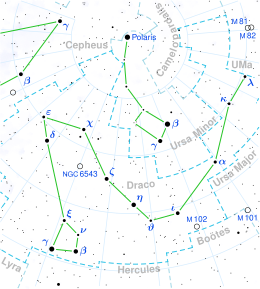Phi Draconis
Phi Draconis (φ Dra / φ Draconis) is a fourth-magnitude variable star in the constellation Draco. It has the Flamsteed designation 43 Draconis. It is also a triple star system where the brightest component is a chemically peculiar Ap star.

The brightness of φ Draconis varies by about 0.04 of a magnitude every 1.7 days. This is due to very strong magnetic fields at the surface of the star, and it is classified as an α2 Canum Venaticorum variable.[2]
φ Draconis is a multiple star system containing three stars. The inner pair form a single-lined spectroscopic binary in an eccentric 128-day orbit. The outermost star orbits the inner pair every 308 years. The outer pair can be resolved visually and have a semi-major axis of 0.752″. A fourth component, C, is also listed in multiple star catalogues, but is only a chance alignment with the triple system.[4]
Phi Draconis Aa is a main-sequence Ap star with a spectral class of B8. The main abundance excess is silicon, although iron and chromium and also notably elevated.[10]
In Chinese astronomy, φ Draconis is called 柱史 (Pinyin: Zhùshǐ), meaning Official of Royal Archives, because this star is marking itself and stand alone in Official of Royal Archives asterism, Purple Forbidden enclosure (see: Chinese constellations).[11]
References
- ^ a b c d e van Leeuwen, F. (November 2007). "Hipparcos, the New Reduction" (VizieR). Astronomy and Astrophysics. 474 (2): 653–664. arXiv:0708.1752. Bibcode:2007A&A...474..653V. doi:10.1051/0004-6361:20078357. S2CID 18759600. Retrieved 2010-11-22.
- ^ a b c Samus, N. N.; Durlevich, O. V.; et al. (2009). "VizieR Online Data Catalog: General Catalogue of Variable Stars (Samus+ 2007-2013)". VizieR On-line Data Catalog: B/GCVS. Originally Published in: 2009yCat....102025S. 1. Bibcode:2009yCat....102025S.
- ^ Gray, R. O.; Corbally, C. J. (2014). "An Expert Computer Program for Classifying Stars on the MK Spectral Classification System". The Astronomical Journal. 147 (4): 80. Bibcode:2014AJ....147...80G. doi:10.1088/0004-6256/147/4/80. S2CID 28584130.
- ^ a b c d e f g Liška, J. (2016). "Analysis of the multiple system with chemically peculiar component φ Draconis". Monthly Notices of the Royal Astronomical Society. 461 (1): 939–947. arXiv:1606.01333. Bibcode:2016MNRAS.461..939L. doi:10.1093/mnras/stw1355.
- ^ a b Mermilliod, J.-C. (1986). "Compilation of Eggen's UBV data, transformed to UBV (unpublished)". Catalogue of Eggen's UBV Data: 0. Bibcode:1986EgUBV........0M.
{{cite journal}}: Unknown parameter|agency=ignored (help) - ^ a b c d Kochukhov, O.; Papakonstantinou, N.; Neiner, C. (2022). "Magnetic field topology, chemical spot distributions, and photometric variability of the Ap star φ Draconis". Monthly Notices of the Royal Astronomical Society. 510 (4): 5821. arXiv:2201.02554. Bibcode:2022MNRAS.510.5821K. doi:10.1093/mnras/stac066.
- ^ a b c d North, P. (June 1998). "Do SI stars undergo any rotational braking?". Astronomy and Astrophysics. 334: 181–187. arXiv:astro-ph/9802286. Bibcode:1998A&A...334..181N.
- ^ a b Tokovinin, Andrei (2018-03-01). "The Updated Multiple Star Catalog". The Astrophysical Journal Supplement Series. 235 (1): 6. arXiv:1712.04750. Bibcode:2018ApJS..235....6T. doi:10.3847/1538-4365/aaa1a5. ISSN 0067-0049. S2CID 119047709.
- ^ "MAST: Barbara A. Mikulski Archive for Space Telescopes". Space Telescope Science Institute. Retrieved 8 December 2021.
- ^ Prvák, M.; Liška, J.; Krtička, J.; Mikulášek, Z.; Lüftinger, T. (2015). "Modelling of variability of the chemically peculiar star ϕ Draconis". Astronomy and Astrophysics. 584: A17. arXiv:1510.01192. Bibcode:2015A&A...584A..17P. doi:10.1051/0004-6361/201526647.
- ^ (in Chinese) AEEA (Activities of Exhibition and Education in Astronomy) 天文教育資訊網 2006 年 6 月 10 日 Archived 2011-05-21 at the Wayback Machine
External links
- Jim Kaler's Stars, University of Illinois: PHI DRA (Phi Draconis)
- An Atlas of the Universe: Multiple Star Orbits

